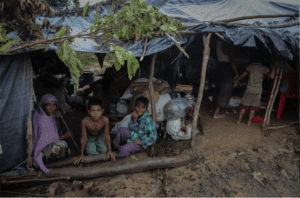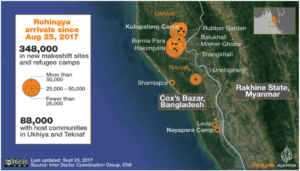
A 75-year-old mother with a broken arm, dragged to safety over three days. Pregnant women on the run, giving birth on the side of the road. A five-year-old girl scarred by an encounter with a military vehicle, sleeping on a dirty hospital floor. These are only a few faces and devastatingly horrific stories of the Rohingya refugees escaping persecution in their ancestral home of Myanmar. They face almost unimaginable threats to their health and safety. And as they flee to overcrowded camps across the border to Bangladesh, the Rohingya are at ever greater risk of major disease outbreaks.
Background
The Rohingya are a persecuted Muslim ethnic group from overwhelmingly Buddhist Myanmar. Myanmar’s government has denied citizenship to Rohingya since 1982 and has periodically attacked their communities. Since 2016, Myanmar’s military has expelled thousands of Rohingya with the help of Buddhist mobs, allegedly in response to attacks by a Rohingya nationalist militia called ARSA. The flood of refugees accelerated after the latest ARSA attack and subsequent military crackdown in August 2017. Over 480,000 refugees have fled over the border to Bangladesh in the last month alone – 60% of them children.
Refugee Camps and Health Risks: Breeding Grounds for Cholera and Malaria

Bangladesh’s food, water, and sanitation infrastructure has struggled to keep pace with the refugee population’s health needs, creating widespread vulnerability to infection. Some camps lack roads to carry in vital supplies and latrines to safely dispose of human waste. Only 20% of refugees have been supplied with official food rations. Few refugees have adequate housing or protection from Bangladesh’s frequent floods. As VIGILINT emergency physician Dr. Barbara Carr has noted, “The Rohingya refugee population is at particular risk [of illness] as their numbers grow faster than the existing aid system can support.”
Cholera and malaria are “among the most worrisome” challenges for the refugees, Dr. Carr explained, because they “can spread quickly and reach epidemic proportions in crowded camps.”
- Inadequate water and sewage infrastructure drives refugees to drink from pools contaminated by waste, spreading waterborne diseases like cholera
- Flooding and limited shelter expose refugees to a booming mosquito population that can spread malaria.
- Widespread malnutrition will exacerbate risks of acquiring both diseases.
How to Help
Rohingya refugees in Bangladesh are at serious risk of malnourishment, disease, and death – but organizations around the world are pitching in to help. Here are some key groups to donate to that are helping to protect Rohingya lives:
- Doctors Without Borders/MSF: The respected medical relief organization has an extensive presence in the Kutupalong refugee camp.
- Global Giving’s Rohingya Refugee Relief Fund: The highly-rated charity is collecting funds to build clinics and field hospitals.
- UNHCR: The UN’s official refugee agency is a major clearinghouse for aid to the Rohingya and other displaced people around the world.
